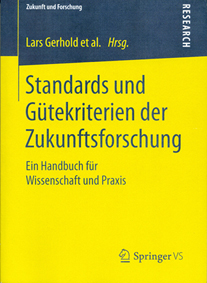What is the difference between "good" foresight and mediocre or bad one? What means quality in futures studies? Which criteria may be applied? And how can I in my own work achieve good, reliable, high-grade and useful results? What are the main points I should pay attention to?
Questions like these were the starting point of a "Task Force Standards" within the Netzwerk Zukunftsforschung in 2010. It took years of work, till this group of seven had established a set of standards and quality criteria for futures studies, invited contributing collegues from the Netzwerk, and published the results as volume four of the series "Zukunft und Forschung" at Springer VS Publishers. In this volume, 18 standards are described with a short summary, central idea, guidelines, frequent pitfalls and a practical example. The editors intend to inspire more discussion about quality in the foresight community, they want to give practitioneers an easy-to-use tool, and in sum contribute to more quality in foresight exercises.

The manual is available at Springer-Link. Front matter and content can be found here. A short version of the manual, calles "Pocketguide" is available for free download at the document server of Freie Universität Berlin:
